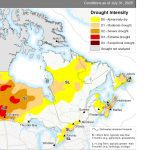The Canadian Prairies haven’t always been ideal farming country.
The dust bowl drought of the 1930s is a better representation of typical prairie weather patterns than what western Canadian farmers have experienced over the past 100 years, a Queen’s University study says.
By uncovering weather patterns stretching back 2,000 years, the study shows extreme droughts across the Great Northern Plains, taking in parts of southern Alberta, Saskatchewan and Manitoba, were the norm rather than the exception.
“Now we have a better idea of what is natural for this area,” said postdoctoral researcher Kate Laird.
Read Also

Alberta eases water access for riparian restoration
Alberta government removes requirement for temporary diversion licence to water plants up to 100 cubic metres per day for smaller riparian restoration projects
Published Dec. 12 in Nature magazine, the study shows the North American Great Plains have experienced wetter than normal weather during the past 750 years.
Previous North American weather studies were based on tree ring samples and dated back only 500 years, Laird said.
This study uses single-celled microscopic algae called diatoms to determine precipitation levels in the last two millennia.
What they found was a dramatic climate shift that swept across the North American grain belt about 750 years ago, creating “sudden” conditions which are suited to farming.
Before AD 1200, drought conditions more severe than the Dirty Thirties were more frequent and persistent, Laird said.
According to the study, the good weather that Canadian farmers have experienced over the last 100 years is an historical anomaly.
The test site was Moon Lake in North Dakota, chosen because it is a closed basin where the lake’s water level varies with the year’s precipitation. During a drought, the water level falls and the lake’s salinity level rises.
Because of their glass-like cell casing, diatoms remain almost perfectly preserved in sediment at the bottom of the lake .
Since saltwater and freshwater diatoms have different characteristics, they can be used to infer weather conditions and precipitation patterns over the years, Laird said.
Researchers took a core sample from the bottom of the lake and studied the top four metres, which contained 2,000 years of sediment deposits including the fossilized algae, or diatoms.
After carbon-dating the layers, researchers studied soil samples in five-year intervals to compare the ratio of salt water to freshwater-preferring diatoms. This provided sufficient information to infer the area’s precipitation over the past 2,000 years.
To confirm their findings, researchers were able to show how results of the diatom study matched instrumental precipitation records kept in the past 100 years, Laird said.
Two distinct patterns
Researchers were shocked to find two distinct weather modes in the area, rather than one pattern altered by the occasional variation in weather.
“We never would have hypothesized that,” Laird said.
And the changeover happened quickly, at least in scientific terms, in about 100 years.
The unanswered question is why this sudden shift occurred, but Laird said scientists have come up with some theories.
“Solar variability could be accounting for the climate change on the Prairies,” she said. Scientists are also pointing to volcanic output changes and ocean/atmospheric links.
With data going back 2,000 years, the study will alter the way scientists look at historical climate patterns forever.
But Laird hopes the findings also act as a wake-up call to the possible impacts of global warming.
“By increasing carbon dioxide we are affecting the climate,” she said, “but how much? We can’t predict that yet.”
“It is a hard thing for the general public and government to try to manage for 50 years in the future but it is really something we should be thinking about.”
The rise in carbon dioxide levels could potentially change something in the climate system to increase the probability of returning to the old patterns, Laird said.
















